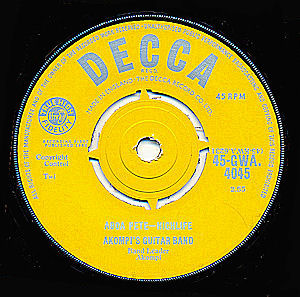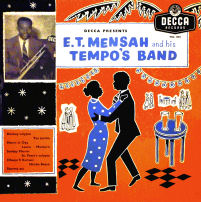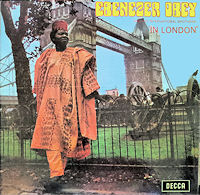Decca West Africa – History
WA, NBS, GWA, NWA, WAX, WAL, WAP/WAPS, DWAPS series
The Decca West African series for single play (SP) 78 rpm shellac discs was introduced in 1947 with WA 101. The first recording tour included artist from the Gold Coast, Nigeria and Yoruba speaking artists from the French colony of Dahomey (today Bénin). Over the following years Decca’s technicians made successive recording tours to Sierra Leone, the Gold Coast and Nigeria. The recordings made during the second tour c.1950 were released in the WA 500 series for Gold Coast artists, the WA 1500 series for Nigerian artists and the WA 2500 series for Sierra Leonean artists. Recordings made during the third tour c.1952 were released in the WA 600 series for Gold Coast artists, the WA 1600 series for Nigerian artists and the WA 2600 series for Sierra Leonean artists. A fourth tour was completed in 1954 and the recordings released in the WA 700 series for Gold Coast artists, the WA 1700 series for Nigerian artists and as additional releases in the WA 2600 series for Sierra Leonean artists. A special but short-lived Decca NBS series also appeared approximately 1957 for Nigerian artists recorded by the Nigerian Broadcasting Service.

By 1956 Decca had built a recording studio in Winneba, Ghana and twice a year two recording engineers was sent to Yaba in Lagos, Nigeria to record on a portable machine. Ghana remained the main focus for Decca’s activities until the early 1970s when the company’s West African branch was relocated to Lagos, Nigeria
New releases were continued in the WA 700 into the WA 800 and WA 900 series for Gold Coast artists, in the WA 1800 and WA 1900 series followed in 1958 by the WA 3000 and WA 3100 series for Nigerian artists and and by further releases in the WA 2600 into the WA 2700 series for Sierra Leonean artists. It should be noticed that not all available catalogue numbers were actually used.
During the 1950s the Decca catalogue featured many of the most popular West African artists including E.T. Mensah and his Tempos Band, The Black Beats, Melody Aces, The Ramblers Dance Band and The Stargazers Dance Band. The period from the mid-1950s to the mid-1960s stands out as the golden era of dance-band highlife with Decca as the most important label in the region.

Vinyl formats
The 45 rpm vinyl single play (SP) disc was introduced in 1959 with 45-WA 940. From 1961 all 45 rpm vinyl single play discs with artists from Ghana and Nigeria were released in the GWA 4000 and NWA 5000 series and given a “45” prefix. Until 1963-64 most new vinyl releases in the GWA and NWA series were also released on shellac with identical catalogue numbers.
The introduction of vinyl discs in 1959 even included the 7 inch / 17 cm EP’s (extended play) in the WAX series and the first 33 rpm 10 inch / 25 cm vinyl LP (long playing) albums in the WAL series. The first vinyl 12 inch / 30 cm LP album in the WAP series was released in 1961. In 1968 the stereo album was introduced and an “S” added to the series prefix (WAPS).
The 12 inch / 30 cm album eventually replaced the singles (SP), the EPs and the 10 inch / 25 cm LP album. After a modest beginning with only 11 albums (WAP / WAPS 20-31) releases from 1961 to 1970 the majority of the 500 albums in the WAPS series were released in the 1970s and 1980s.
Decca (Nigeria) Ltd.
Decca’s West African series was originally manufactured in the UK. By the early 1970s the manufacture was taken over by the pressing plant R.M.N. Ltd. in Lagos, in which Decca (Nigeria) Ltd. held a 50% stake. The other half was owned by EMI Nigeria Ltd.
Records manufactured in Nigeria and distributed by Decca’s West African branch were also released on the Star label in the SRN (SP), SREP (EP) and SRPS (LP) series for Haruna Ishola’s and I.K. Dairo’s Star Records. The Decca FN series (SP) was used for recordings made by Ghana Film Company, the Decca TPN series (SP) for releases made for the Ets. F-Gaz in Porto-Novo and the Decca TXP series (SP) for special releases for the Alofty Music Shop in Lagos. Licensed Congolese single play records from Fonior / Decca France’s Decca, African and Fiesta labels were re-released in the CD series on the Congo Decca label – later renamed Afric Decca. Similarly, Fonior / Decca France re-released a number of albums in France produced by Decca’s West African branch plus a number of other Nigerian labels.
In the early 1970s the economic crises in Ghana brought new releases with Ghanaian artist to a standstill. The last vinyl single in the GWA series with Ghanaian music was released in 1972. The same fate befell a dwindling number of new releases with Sierra Leonean artists. By the mid-1970s the company focused uniquely on Nigerian artists.
 |
 |
Afrodisia Ltd.
The Nigerian indigenization decrees of 1972 and 1977 led to the gradual take-over of Decca (WA) Ltd. by Nigerian owners including Chief Moshood Abiola and band-leader-musician Ebenezer Obey. Beginning in 1976 the Decca label and the WAPS series was gradually replaced by the Afrodisia label and the DWAPS series. The last album in the WAPS series was released around 1983. Three new album (LP) labels were also introduced. Soundpoint in the SOP series, Blackspot in the B SPOT series and Deram in the DLPS series.
By 1981 the company was 100% Nigerian owned and changed its name to Afrodisia Ltd. Vinyl albums were released by the Afrodisia company until 1989. In 1983 Ebenezer Obey secured the rights to all his past recordings, using the original Decca and Afrodisia catalogue numbers for re-releases on his new Obey label and OPS catalogue numbers for new releases.
The indigenization of company ownership eventually severed the links to the international market. In combination with the change in format from vinyl to cassettes, new releases with Nigerian music have become increasingly more difficult to come by outside Nigeria since the 1990s than was the case from the 1950s into the 1980s.
Historical legacy
What is unique about Decca as a West African label is its longevity. Decca, unlike its UK rival EMI, stayed on when independence approached for the British colonies in Africa. Where EMI terminated all their shellac series across the continent and withdrew to two distribution companies based in Nigeria and South Africa primarily set up for re-releases of its international catalogue, Decca remained in the market. It managed the transition from the colonial period well into the post-independence era, the transition from shellac to vinyl and from the 45 rpm formats to the 30 cm album as the principal format for new releases. However, as a West African label it did not survive, be it the sale of the UK parent company to Polygram in 1980, the economic and political constrains it encountered in Ghana and Nigeria in the 1970s or the increasing numbers of illegally copied cassettes which flooded the market in the 1990s.
The current status of Afrodisia Ltd. is not known.
Discographical note
Where a missing track title is indicated by a matrix number and a recording date, a Decca register of master tapes in the form of an Excel spread sheet is the source of information. Other recording dates are from the spread sheet as well. Some recording date, e.g. “01-02-1962”, cover 28 tracks and 8 dance-bands, which seem unlikely. Perhaps, it was the date the master tapes were approved for release. In 1958 Decca began to print the year on the labels a disc was “first published”.
Page created 03/11/2012 © Flemming Harrev – latest update 11/08/2020
